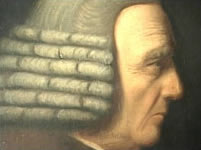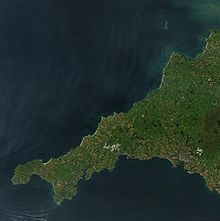William Cookworthy
William Cookworthy (born April 12, 1705 in Kingsbridge , Devon , England , † October 17, 1780 in Plymouth ) was an English pharmacist , chemist and inventor . He is considered to be the pioneer of both the kaolin industry in Cornwall and Devon and the porcelain manufacture in England.
youth
William Cookworthy was the son of the Kingsbridge weaver William Cookworthy. His mother, Edith, née Debell, was from St Martin-by-Looe in Cornwall. He was born the oldest of seven children. His siblings were Sarah (* 1706), Jacob (* 1709), Susannah (* 1711), Mary (* 1714), Philip (* 1716) and Benjamin (* 1717).
Cookworthy's father died in 1718. The family lost their modest prosperity when the South Sea bubble burst in 1720. Cookworthy had to drop out of school. But he got the opportunity to do an apprenticeship in the pharmacy of the brothers Timothy and Silvanus Bevan in London free of charge. The Bevans were Quakers , as were Cookworthy and his family. Due to a lack of financial resources, Cookworthy had to travel from Kingsbridge to London on foot. As part of his apprenticeship, he acquired pharmaceutical and chemical knowledge as well as knowledge of metallurgy , Latin, French and Greek.
Pharmacist in Plymouth
After completing his apprenticeship in 1726, his masters opened him the offer to work in their wholesale pharmacy in Plymouth, a port town on the south coast of Devon and right on the border with Cornwall . Cookworty accepted this offer and was so successful with his work that he was accepted as a partner in 1735. From then on, the wholesale trade was called Bevan and Cookworthy . In 1746 the Bevans could be paid out. Instead, Cookworthy took his brothers Philip and Benjamin into the company, which from then on bore the name Messrs William Cookworthy and Company .
In 1735 Cookworthy married Sarah Berry of Wellington . With her he had five daughters: Lydia (* 1736), Sarah (* 1738), Mary (* 1740) and the twins Elizabeth and Susannah (* 1743). Sarah Cookworthy died in 1746.
Kaolin and porcelain
After attempts had been unsuccessful for centuries in Europe to imitate Chinese porcelain, Johann Friedrich Böttger and Ehrenfried Walther von Tschirnhaus in Dresden succeeded for the first time in December 1707 in making a crucible out of hard porcelain . The manufacturing process could still be kept secret for years. In the meantime, the French Jesuit priest Francois Xavier d'Entrecolles, who had lived in China since 1698, had described details of the porcelain production he observed in Jingdezhen in two letters from 1712 and 1722 , including the use of two types of clay : Kao-lin and Pe-tun-se, a rock containing feldspar and mica .
The extreme south-west of England, starting in the east with the Dartmoor up to the western tip at Land's End , is characterized by granite deposits that are partly characteristic of the landscape and occur over a large area. Both feldspar and mica are mineral components of granite. Kaolinite, the rock-forming mineral of kaolin, is a weathering product of feldspar, among other things.
The French Father's findings were known to Cookworthy when he began making porcelain in the early 1740s. On one of his business trips to Cornwall in June 1746, while visiting the Godolphin family's Great Work Mine west of Helston , Cookworthy discovered that local miners were mending their ovens with a white, fine clay. He took samples from the place of origin of the material, the nearby Tregonning Hill, as he suspected that the material was suitable for the production of porcelain. In the following years Cookworthy spent a lot of time looking for other occurrences of this species in other locations in Cornwall and Devon and experimenting with the materials found there. The attempts with the found materials, which were locally referred to as Moorstone , Growan , Growan Clay or Growan Stone , were successful: Cookworthy was the first to succeed in England in producing a porcelain that could rival Chinese porcelain in terms of appearance and quality. On March 17, 1768, he was granted a patent for "a type of porcelain reinvented by him consisting of Moorstone and Growan or Growan-Clay."
In the same year at the latest, Cookworthy and several partners founded a porcelain factory in Plymouth, the Plymouth China Works . One of the partners, Richard Champion from Bristol , became managing director. The company mainly produced tea sets, jugs and vases. Also financially involved was Thomas Pitt , later Lord Camelford, a nephew of William Pitt . On land belonging to Pitt, in the hamlet of Carloggas, northwest of St Austell on the edge of the Hensbarrow, Cookworthy had discovered a deposit of kaolin that contained very little black mica and was therefore suitable for particularly fine china. In the immediate vicinity there was also clay stone , a fine-grained, partially kaolinized, iron-poor but feldspar-rich rock similar to Pe-tun-se, which could also be used for porcelain manufacture. Pitt supported Cookworthy in his endeavors and was also financially involved in the porcelain factory in Plymouth. As early as 1770 the porcelain factory was moved to Bristol and merged with a local pottery.
further activities
John Smeaton developed a collaboration with Cookworthy waterproof mortar , hydraulic lime called. This invention enabled Smeaton to rebuild the Eddystone lighthouse, which stood on a small rock in the sea south of Portsmouth, between 1756 and 1759 .
As a pharmacist in a port town, Cookworthy had regular dealings with sailors. When the British ship's doctor James Lind was able to show in a study that the dreaded ship's disease, scurvy , could be combated by taking in vitamin C , he campaigned for this knowledge to be disseminated among ship's officers and ensured that vitamin C was available on the ships. Containing foods such as lemons or sauerkraut were brought along.
Together with Pastor Thomas Hartley, Cookworthy translated several theological works by Emanuel Swedenborg from Latin into English.
Late years
In 1774 Cookworthy sold his shares in the china factory and the patent to Champion. In addition to the purchase price, he received a license fee for each piece sold in the future.
Cookworthy died on October 17, 1780. He was buried in the family vault in the Westwell Street cemetery in Plymouth.
aftermath
The pharmacy in Plymouth passed to his brother Benjamin after Cookworthy's death and after his death in 1785 to Francis Fox, the son of his daughter Sarah. After several changes of ownership and name, it existed until 1974, most recently under the name Messrs Balkwill & Company (Chemists) Ltd.
Richard Champion tried in 1777 to obtain an extension of the patent, but achieved only partial success, which enabled other manufacturers, including Josiah Wedgwood , to use the raw materials from Cornwall and Devon for their own ceramic products. The costs of the license disputes as well as the loss of the monopoly position brought Champions operation into financial difficulties. In 1782 he sold the company and license to the New Hall Porcelain Company from Shelton, now a part of Stoke-on-Trent , Staffordshire . There he also worked in porcelain manufacture for a few years. Champion later emigrated to Carolina , where he also died.
Tregonning Hill and the Godolphin Great Work Mine are now part of the Cornwall and West Devonian Mining World Heritage Site .
Cookworthy's insights into the usefulness of the kaolin deposits in Cornwall and Devon enabled the development of a thriving mining industry in these areas. Since a large part of the recovered material was and is exported by ship, in the end only via the ports of Fowey and to a lesser extent from Par , additional jobs and infrastructure were created in nearby port cities. This development made it possible for the economic loss associated with the decline in ore mining in Cornwall, which began around the same time, to be at least partially offset. The annual production of kaolin from Cornwall and West Devon was 3.28 million tons after the 1988 maximum. in 2008 1.36 million tons, 88 percent of which were exported. This makes the UK the largest producer of kaolin in the EU and the fourth largest in the world. The extraction is now limited to the region northwest of St. Austell, also known as Hensbarrow, and areas on the southwest corner of Dartmoor. Other deposits are currently no longer being exploited. Due to the large-scale excavations on the one hand and the accumulation of waste material , often in the form of high pointed cones, on the other hand, the kaolin mining is characteristic of the landscape in the regions mentioned.
References and comments
- ^ Samuel Smiles: Josiah Wedgwood - His Personal History. London 1897, paperback new edition 2009, p. 177 ISBN 978-1-11312577-4
- ^ Cornish Mining World Heritage Site: Tregonning and Trewavas Mining District
- ↑ Values in each case dry weight
- ↑ British Geological Survey: United Kingdom Minerals Yearbook 2008. Available online here
- ^ British Geological Survey: World Mineral Production 2003-2007. Available online here
literature
- Theodore Compton: William Cookworthy . London 1895, reprint 2007. ISBN 978-0-54821090-1
- John Penderill-Church: William Cookworthy, 1705-80: A Study of the Pioneer of True Porcelain Manufacture in England . Truro 1972. ISBN 978-0-85153095-6
- Hubert C. Fox: The story of William Cookworthy: maker of porcelain and man of peace . Southampton 1995. ISBN 1-89955018-6
- Angus JL Winchester: Cookworthy, William (1705-1780). In: Henry Colin Gray Matthew, Brian Harrison (Eds.): Oxford Dictionary of National Biography , from the earliest times to the year 2000 (ODNB). Oxford University Press, Oxford 2004, ISBN 0-19-861411-X , ( oxforddnb.com license required ), as of 2004
Web links
- Encyclopaedia of Plymouth History: William Cockworthy ( Memento of August 21, 2008 in the Internet Archive ) (English)
- Portrait of William Cookworthy on the Royal Pharmaceutical Society of Great Britain website . ( Memento July 22, 2009 in the Internet Archive )
- Tregonning Hill China Clay China Stone and Brick Works ( September 25, 2006 memento in the Internet Archive ) - The Trevithick Society: Tregonning Hill, Cookworthy's first kaolin pit. (English)
- Contents of the letters from Father d'Entrecolles.
- Company history of the pharmacy founded by Cookworthy and Bevan. (English) ( Memento from February 18, 2013 in the web archive archive.today )
- Article on Plymouth porcelain (illustrated) from Every Woman's Encyclopaedia. (English)
| personal data | |
|---|---|
| SURNAME | Cookworthy, William |
| BRIEF DESCRIPTION | English pharmacist, chemist and inventor |
| DATE OF BIRTH | April 12, 1705 |
| PLACE OF BIRTH | Kingsbridge , Devon , England |
| DATE OF DEATH | October 17, 1780 |
| Place of death | Plymouth |

